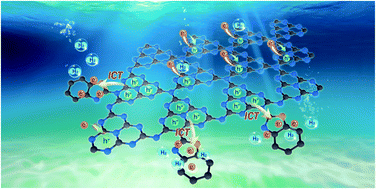Unravelling intramolecular charge transfer in donor–acceptor structured g-C3N4 for superior photocatalytic hydrogen evolution†
Abstract
Construction of alternating donor–acceptor (D–A) units in g-C3N4 is an effective strategy to achieve more effective charge carrier separation towards improved photocatalytic performance. However, the charge carrier kinetics, especially the vague intramolecular charge transfer (ICT) details and structure–performance relationship remain unknown. Herein, a series of D–A structured g-C3N4 photocatalysts with improved performance were synthesized by introducing 2-aminobenzothiazole (ABT) into the g-C3N4 framework. Remarkably, up to 3.83-fold improvement in photocatalytic hydrogen evolution was realized at 0.8 wt% ABT incorporation. It shall be due to the broadened visible light absorption range (λ ≤ 700 nm) and accelerated charge carrier separation which originated from the ultrafast ICT (τ1 = 112.20 fs) between the benzothiazole group and heptazine ring. The boosted performance is highly associated with the purposely introduced D–A structure, which may shed light on designing of analogues with better photocatalytic hydrogen evolution performance.



 Please wait while we load your content...
Please wait while we load your content...